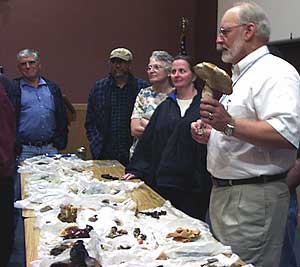 August 18, 2003 Ketchikan, AK - Friday evening the Southeast Alaska Discovery Center presented a special Friday Night Insight program - "Mushrooms of Alaska". The guest speaker was Dr. Gary A.
Dr. Laursen arrived from Prince of Wales (POW) Island on Friday where he had spent a week collecting mushrooms. He also visited Coffman Cove, Thorne Bay, Craig and Naukiti speaking with community members. For the program, Dr. Laursen placed approximately 40 different dripping, attached, hanging, covering, and encrusting plant and plant-like organisms called cryptogams on a table. The group represented 12 different species that he had collected on POW. After welcoming the approximately 30 persons attending the special program at the Alaska Discovery Center, he asked everyone to gather around the table. He gave an in-depth description of each of the 12 different species and provided the group with jeweler's binoculars which allowed for a close-up view of the 'mushrooms'. The program ended with a showing of a 30-minute mushroom slide presentation. In Dr. Laursen's presentation he noted that the presence of cryptogamic organisms holds significant promise for potential development of renewable and sustainable harvest practices. This group of organisms is highly sought after for their aesthetic values, by the floral industry, nature groups, and organizational outings, undergraduate student course work, graduate student research projects, supplying local farmer's markets with edibles, mycophagy, specimen support for biological supply houses, and in the development of cottage industries. According to Dr. Laursen, presently for Alaskan forests there exists no policy, program, or protocol pertinent to the sustainability of these vastly important species groups. He said we know so little about their species richness, relative abundance, frequency or occurrence reproductive biology, roles played, and contributions made to dynamic balance, and regeneration time. Natural perturbation effects such as fire and unnatural disturbances such as over harvesting, lack of biodiversity assessments, understanding genetic plasticity, and habitat preferences shown, must be studied for greater understanding. At this point in time only a few cottage mushroom 'farming/growing' attempts have been made in Alaska. According to Dr. Laursen, part of the problem is that there are tremendous up front expenses without guarantees of success in growing, maintaining an even production, or marketing the products. A few folks 'forage' for the economic gain to be gleaned by collecting birch polypore/bracket fungi for drying and grinding for added value to pipe smoking tobacco, or drying and ashing for added value to chewing tobacco. Others simply know of a few easily recognizable edible species found in spring, summer, and fall that are not easily confused with lesser well know species that may be harbingers of life threatening toxins or gastrointestinal upsetting contaminants. Laursen says no 'Holy Grail' for the growth of any of these organisms in Alaska exists. Anyone attempting to culture them, out of necessity 'reinvents the wheel'. Dr. Laursen will be giving another mushroom presentation in Ketchikan in September.
Editor's note:
|
||
